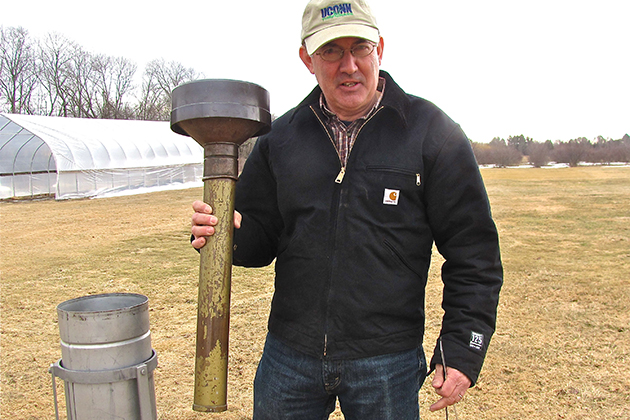
Every day at 8 a.m. for the last 45,625 days (give or take a day or two), weather information at UConn’s Plant Research and Education Facility on Agronomy Road has been recorded and sent to the National Weather Service. That’s every day for 125 years. It’s a long time and a lot of data.
In recognition, the National Weather Service recently presented the College of Agriculture and Natural Resources with a 125 Year Honored Institution Award.

UConn is a participant in the National Weather Service Cooperative Observer Program (COOP), a weather and climate observing network with nearly 12,000 stations nationwide. Few if any of these sites can compare for length of service. UConn is the oldest of approximately 110 observation points in Connecticut, and certainly one of the oldest, if not the oldest, continually operating COOP site in the country.
Research Farm manager Steve Olsen ’85 (CANR), who began working at the farm in 1988, says that from the beginning in 1888, and even when he first came to work at the farm, all information was recorded by hand and then mailed to the National Weather Service. In 1992, the University purchased a Campbell Scientific Weather Station that records temperature data every 15 seconds and then averages it in half-hour segments. “Now, I can sit at my desk and send off electronic data to the National Weather Service every morning,” says Olsen.
In addition to temperature, precipitation is monitored – both rainfall and snowfall – in special collection devices, and that information is also recorded and shared electronically.


The history of recording weather observations in the U.S. dates back to the days of George Washington, Benjamin Franklin, and Thomas Jefferson, all of whom were keenly interested in the weather. It was Jefferson who first envisioned a network of weather observers in six states, including Virginia, Massachusetts, Pennsylvania, Connecticut, New York, and North Carolina.
In 1849, the Smithsonian Institution set up a system for receiving weather data from telegraph companies and that data was used to produce weather charts. At the time, there were 150 volunteers sending in their observations.
The information we collect … has helped generations of Plant Science students and faculty members in their research … we’re happy that we can share it with the [National Weather Service] at the same time. (Steve Olsen)
When the Weather Bureau (now the National Weather Service) was created in 1890, the COOP program became its responsibility. On a national basis, the information received is used to predict local weather and develop flood forecasts. Data collected from sites that have unbroken records for at least 80 years, including UConn, is used to create the U.S. regional climate record.
In addition, data collected via COOP helps local officials make long-term planning decisions about water resources; is helpful in the settlement of billions of dollars of insurance and legal claims following major weather events such as Hurricane Sandy; and assists in the determination of federal disaster aid.
“Our farm is first and foremost a research site,” says Olsen, “and the information we collect relative to the temperature and level of precipitation has helped generations of Plant Science students and faculty members in their research.
“When you drive up to the farm office, it’s easy to pass right by the weather monitoring devices without a glance. They really aren’t very impressive to look at. But the information they provide us with is a big part of what we do here, and we’re happy that we can share it with COOP at the same time we use it for our academic and scientific efforts.”



